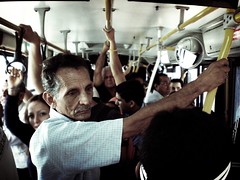 This post is by EWG's stellar media intern, Sameem.
This post is by EWG's stellar media intern, Sameem.
The buzz on gas prices has people rethinking the way they travel. USA Today recently reported record breaking public transit ridership based on a study by the American Public Transportation Association (APTA). For the months of January through March 2008 ridership increased 10% when compared to the same months in 2007. And while many riders are making the switch due to rising fuel prices, many of them stick to public transit for its “service and convenience," according to Linda Robson of Seattle's Sound Transit. For riders fortunate enough to live and work near major bus and rail lines, the shift makes a lot of sense.
But how many people really have this good fortune? According to the 2006 US census, only about 1 in 5 households. The logical solution: Make bus and rail lines more extensive. The bleak reality: No one wants to pay for it.
Most transit systems are already aging and underfunded. A recent study by the Brookings Institution reported that "45 percent of the nation's subway cars were over 20 years old." The report also noted that of this 45%, half are at least 25 years old – the age at which the Federal Transit Administration recommends replacement. The percentage of rail stations in good condition has fallen from 61% in 1995 to 35% in 2004. It’s evident that the transit system was in dire need of reworking even before these record breaking ridership numbers.
So where does the money come from? At the moment, most transit projects are state and locally funded, with some federal money. The Brookings report also noted that the federal government will generally match state and local funds up to 80-90% for highway projects, but only up to 50-60% for transit projects. Under current policy, it’s clear that spending on public transit takes a backseat. But with the recent increases ridership, it’s time policy makers rethink their spending habits.
APTA is hopeful that an increased investment in transit systems will lead to a reduction on CO2 emissions. According to an APTA report, public transit could potentially reduce CO2 emissions by 37 million tons annually. Currently, they estimate that 55% of household CO2 emissions are a result of privately owned vehicles. With policy and planning reform, this number could be reduced by 30%.
With all that said, I love driving. It’s fun, convenient, and sometimes very necessary. But, given the option, I’d rather have access to a walkable community with easy public transport for my day-to-day activities, and leave driving as a leisurely and/or occasional activity. At the end of the day, it’s important for people to have a wide array of affordable, clean, convenient and energy efficient options for transportation. Federal spending should reflect the changing needs and demands of its population.
Photo by Jorg Etilico.